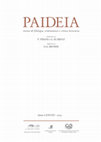Papers by Kirk Freudenburg
Shadi Bartsch, Kirk Freudenburg & Cedric Littlewood, - PhilPapers
The Walking Muse: Horace on the Theory of Satire
American Journal of Philology, 1995
... and to the conventions of Hellenistic moral literature, however, Freudenburg reveals the soph... more ... and to the conventions of Hellenistic moral literature, however, Freudenburg reveals the sophisticated mask through which the writer distances himself from the speaker in these earthy diatribes--a mask that enables the lofty muse of poetry to walk in satire's mundane world of ...

Paideia: Rivista di Filologia, Ermeneutica e Critica Letteraria, 2023
This study explores the emergence of xenophobic excoriation as a mode of humorous complaint in th... more This study explores the emergence of xenophobic excoriation as a mode of humorous complaint in the satires of Juvenal in the early second century C.E. It is argued that, when viewed against the backdrop of earlier satiric forms, Juvenal’s hostile fixation on outsiders as enemies of Rome is sui generis, with no meaningful precedents in formal verse satire, epigram, or Petronius. Closer analogues are located in the Elder Cato (his speeches, the De Re Rustica, the Origines) and, to a lesser degree, in certain speeches of Cicero. But, in the end, such works are characterized by much higher levels of restraint than what one sees in Juvenal, especially in the untethered hatreds that are put on display in Satires 3 and 15. When Juvenal’s Umbricius rails against foreigners invading Rome (Satire 3), he does so as a latter-day Aeneas, escaping from a city overrun by invading Greeks. It is here, in the furor-inspired hatreds of certain crazed and/or short-sighted characters of the Aeneid-- characters who, in fact, fail to grasp the full logic of Jupiter’s plan for an inclusive, multi-cultural empire-- that close analogues to the attitudes of Juvenal’s speakers are to be found. The paper concludes with a discussion of the built-in ironies of Roman identity, and the destabilizing dissonances that inhere in all nativist rhetorics naming ‘others’ who do not belong.
Musa pedestre. Storia e interpretazione della satira in Roma antica
Carocci eBooks, 2007
Selezione di articoli che compongono un panorama del genere satirico a Roma: autori principali, t... more Selezione di articoli che compongono un panorama del genere satirico a Roma: autori principali, temi, forme, genere, e problemi della ricerca. Contiene uno specifico lavoro, scritto con A. Cucchiarelli, sulla simbologia del corpo nella poetica satirica
Seeing as Telling
Oxford University Press eBooks, Feb 28, 2023
The “Seeming” of the “Seen”—Narrative as Vision in Ancient Epic
Oxford University Press eBooks, Feb 28, 2023
Precedents in Earlier Roman Poetry
Oxford University Press eBooks, Feb 28, 2023
Chapter Two. Aristotle and the Iambographic Tradition: The Theoretical Precedents of Horace's Satiric Program
The Walking Muse, 1992
Studi Italiani di Filologia Classica (4th Series Vol. 20), 2022
This paper examines the richly problematic messaging of the ‘Raging
Aufidus’ image near the cente... more This paper examines the richly problematic messaging of the ‘Raging
Aufidus’ image near the center of Horace’s first satire. Via an exploration
of killer torrents and other raging waters in earlier Greek and Roman
literature, beginning with Homer, it demonstrates that the symbolism of
Horace’s Aufidus is much more expressive and fully entailed than it has
commonly been taken to be. Besides functioning as an Epicurean soul
image (à la Lucretius), and an assertion of decently restrained poetic
values (à la Hesiod, Aristophanes, Callimachus, and many others), the
image, highly personal to Horace himself, exemplifies the central message
of the poem by saying just ‘enough’ about unspeakable things, but
not going past the limits (fines) of acceptable political speech.
Chapter Four. Callimachean Aesthetics and the Noble Mime
Chapter Three. The Satires in the Context of Late Republican Stylistic Theory
SOLVS SAPIENS LIBER EST: recommissioning lyric in Epistles 1
Traditions and Contexts in the Poetry of Horace

La corte imperial
Tras un periodo inicial de estabilidad, la corte de Neron experimento un rapido y progresivo proc... more Tras un periodo inicial de estabilidad, la corte de Neron experimento un rapido y progresivo proceso de transformacion a medida que los consejeros que habian sido colocados para guiar los esfuerzos en la gobernanza del emperador fueron cediendo el paso a amiguetes que acapararon poder para si mismos alimentando los delirios de este. Neron fue apoyado en los primeros anos de su reinado por un estrecho circulo de colaboradores que incluian a Anneo Seneca, Afranio Burro y su propia madre, Agripina. Sus actividades fueron responsables de los tempranos “maravillosos anos” del reinado del emperador (el llamado quinquennium Neronis), que son bien conocidos no solo porque llamaron la atencion de los historiadores –quienes vieron a estos consejeros intentando y fracasando una y otra vez en su proposito de controlar al joven y recalcitrante Neron–, sino tambien porque sus actividades se llevaban a cabo en el ojo publico por cuestion de necesidad politica. Este trio conformaba el dream team de...
Journal of Roman Studies, 2014

Romans Prefigured the Status Protocols of Evander S Palatine
Felice Le Monnier, 2017
This paper analyzes Virgil's remake of a Homeric formula at Aen. 8.454-68, lines describi... more This paper analyzes Virgil's remake of a Homeric formula at Aen. 8.454-68, lines describing Evander's early-morning rise on the Palatine to meet his overnight guest, Aeneas. Of the several changes that Virgil makes to the scene, the most significant concerns the way in which the activities of host and guest are coordinated so that they rise simultaneously, then meet halfway between their lodgings. This paper undertakes to show that, despite being solidly ‘Homeric’ in nearly all of its parts, Virgil's remake of the scene is deeply structured by the codes of Roman social behavior, as a prefiguration of those behaviors. Seen for its engagement with (highly performative) social protocols, Virgil's version of the scene reads as fascinating case of Homer’s Roman transformation: the restructuring of epic codes by the codes of the mos maiorum.
Chapter One. Horatian Satire and the Conventions of Popular Drama

The Po(e)ts and Pens of Persius’ Third Satire (The Waters of Roman Satire, Part 2)
Antike Erzähl- und Deutungsmuster, 2018
This paper examines the odd assortment of liquids that color the pages of Persius' third ... more This paper examines the odd assortment of liquids that color the pages of Persius' third satire. The core argument is that the boiling pots, leaky pens, and jaundiced bodies of this poem are uniquely Stoic articulations of ideas that are basic to Horace's programmatic satires (1.4 and 1.10), symbolizing undisciplined souls that are ridden with vice, and prone to 'spilling out' in excessive ways. This conceptualization of vice, it will be argued, owes much to Stoic theories of continentia 'self-control' as a project of emotional discipline, imagining that project as a quasi-literal effort to 'contain' and 'hold in' (continere) contents that threaten to burst out. It is the working out of these ideas via multiple images of leaking vessels in Persius' third satire, many of which are drawn from the pages of Virgil, that is the primary focus of this paper.
Petronius, Realism, Nero*
Introduction: Angles on an Emperor
A Note on Trimalchio's Three (Equals Two) Libraries
The Classical Quarterly, 2017
At Petron. Sat. 48.4 Trimalchio makes a famous boast about owning three libraries: tres bibliothe... more At Petron. Sat. 48.4 Trimalchio makes a famous boast about owning three libraries: tres bibliothecas habeo, unam Graecam, alteram Latinam. I have three libraries: one Greek, another Latin.









Uploads
Papers by Kirk Freudenburg
Aufidus’ image near the center of Horace’s first satire. Via an exploration
of killer torrents and other raging waters in earlier Greek and Roman
literature, beginning with Homer, it demonstrates that the symbolism of
Horace’s Aufidus is much more expressive and fully entailed than it has
commonly been taken to be. Besides functioning as an Epicurean soul
image (à la Lucretius), and an assertion of decently restrained poetic
values (à la Hesiod, Aristophanes, Callimachus, and many others), the
image, highly personal to Horace himself, exemplifies the central message
of the poem by saying just ‘enough’ about unspeakable things, but
not going past the limits (fines) of acceptable political speech.
Aufidus’ image near the center of Horace’s first satire. Via an exploration
of killer torrents and other raging waters in earlier Greek and Roman
literature, beginning with Homer, it demonstrates that the symbolism of
Horace’s Aufidus is much more expressive and fully entailed than it has
commonly been taken to be. Besides functioning as an Epicurean soul
image (à la Lucretius), and an assertion of decently restrained poetic
values (à la Hesiod, Aristophanes, Callimachus, and many others), the
image, highly personal to Horace himself, exemplifies the central message
of the poem by saying just ‘enough’ about unspeakable things, but
not going past the limits (fines) of acceptable political speech.
Informing the book’s theoretical approach are recent cognitivist and constructivist studies of how audiences watch narrative films and make sense of what they are being given to see. By looking to the world of narrative films, where directors use shots craftily edited to cue audiences to ‘fill in’ for what the camera itself cannot show, the book locates new narrative content lurking in old places, brought to life within the imaginations of readers. The end result is a new approach to the question of how ancient epic tales convey narrative content through visual means.
For students working at intermediate and advanced levels of Latin, this book makes the satires of Horace’s second book of Sermones readable by explaining difficult issues of grammar, syntax, word-choice, genre, period, style. For scholars who already know these poems well, it offers fresh insights into what satire is, and how these poems communicate as uniquely ‘Horatian’ expressions of the genre.